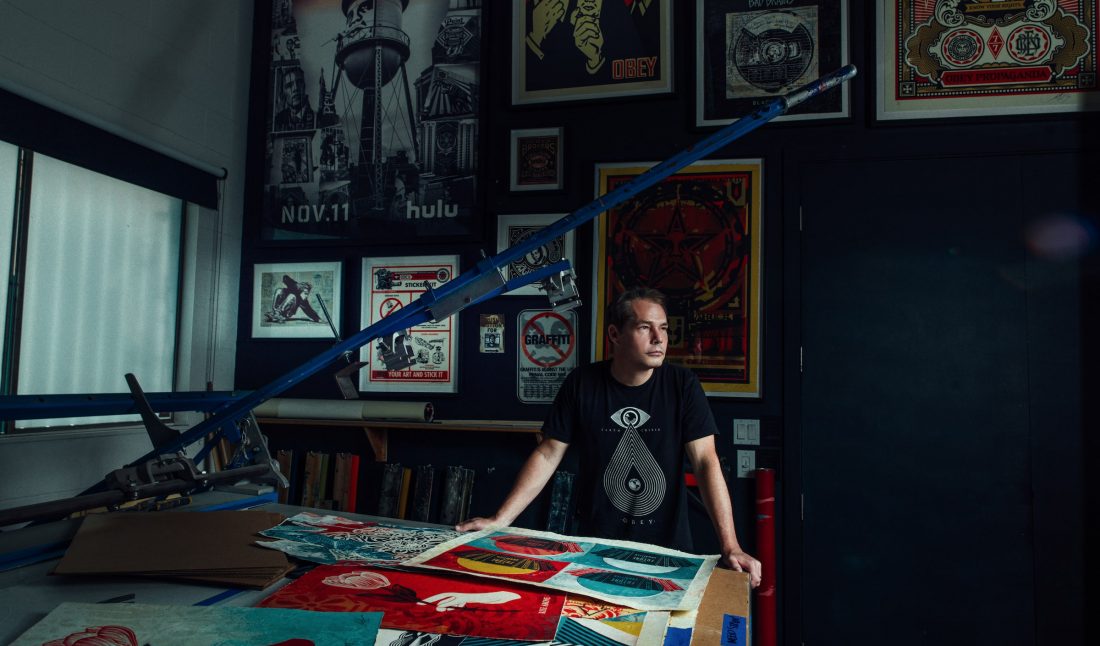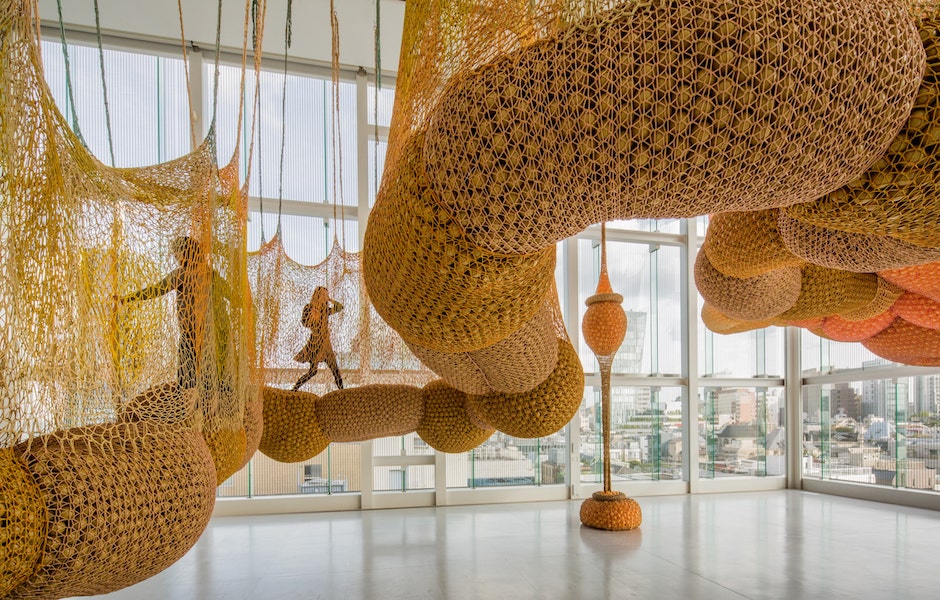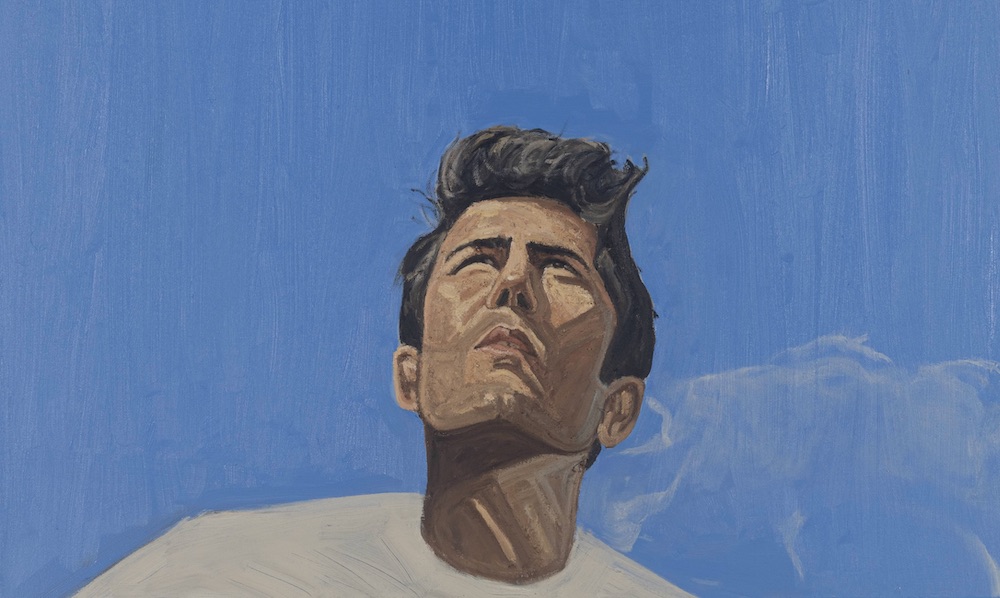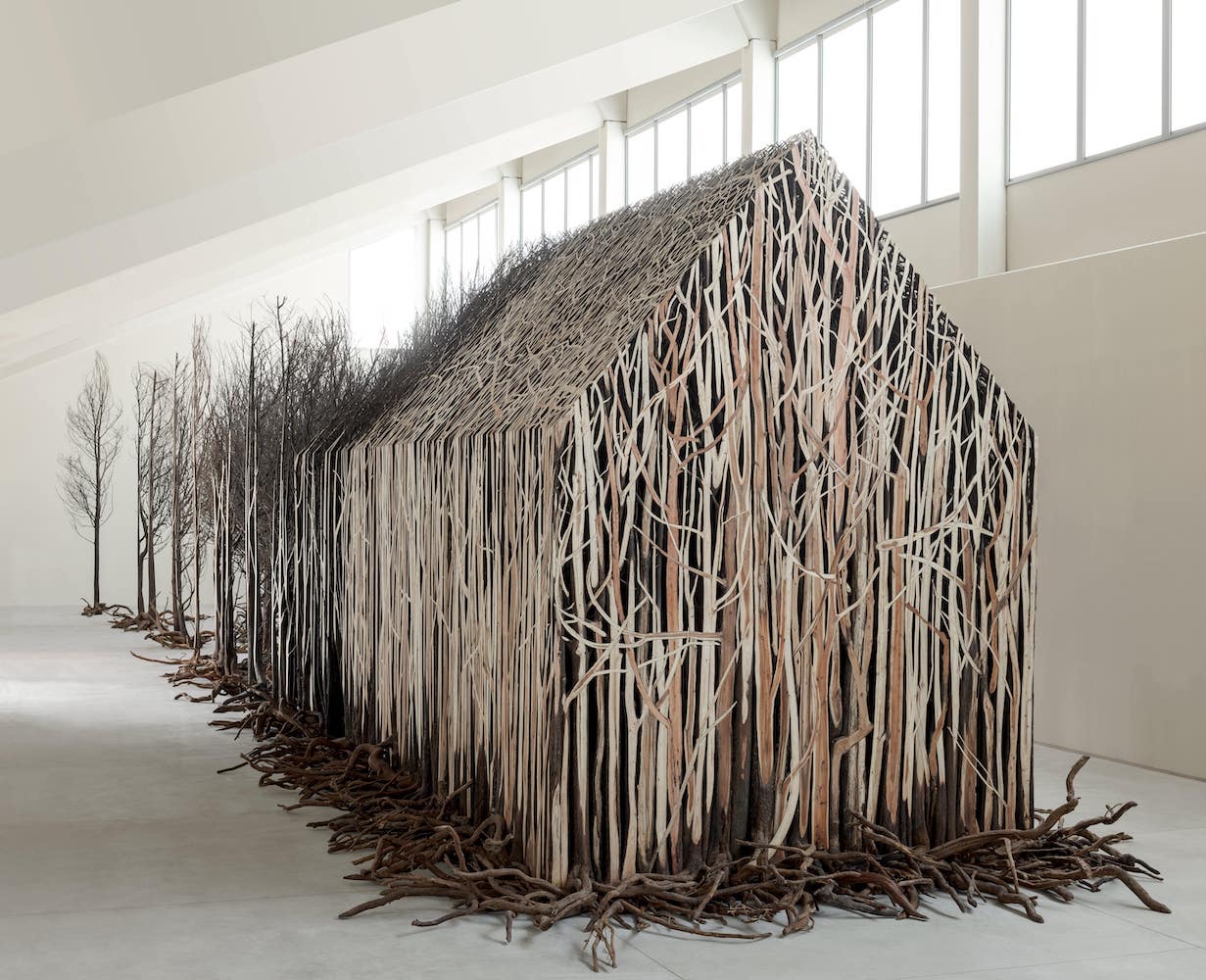Shepard Fairey’s “Backward Forward” is on view at the Dallas Contemporary through July 23, 2023. The exhibition started with a conversation between the artist and his longtime friend Pedro Alonzo, an adjunct curator at the museum. After witnessing the evolution of Fairey’s art over the years, Alonzo wanted to present new work that focused on what he called the artist’s “narratives for humanity.” With that in mind, Fairey began creating pieces around social justice themes that powerfully activate the museum’s galleries.
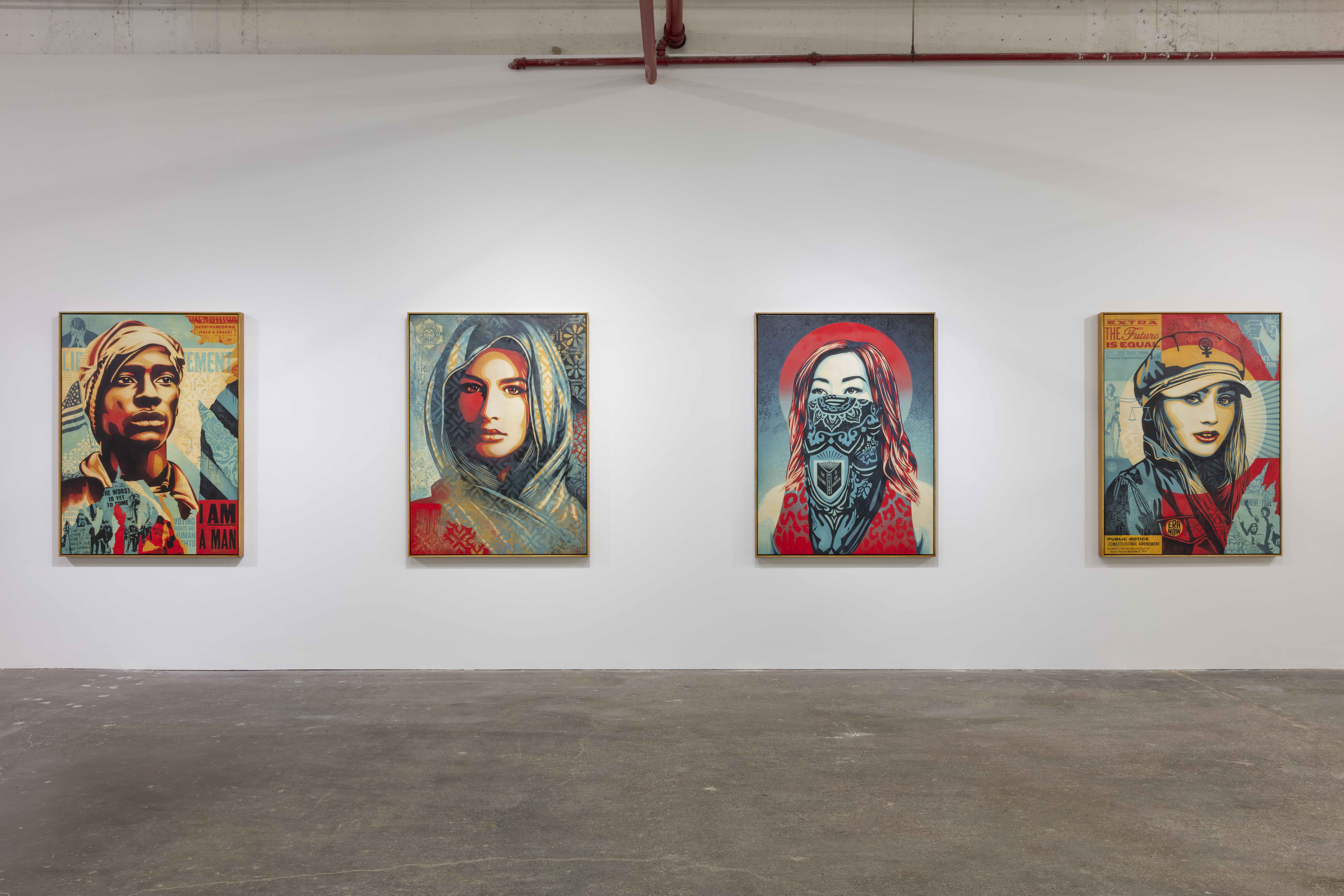 Shepard Fairey, installation view of “Backward Forward” at the Dallas Contemporary, photo by Kevin Todora, courtesy of the artist.
Shepard Fairey, installation view of “Backward Forward” at the Dallas Contemporary, photo by Kevin Todora, courtesy of the artist.
Fairey asks two questions in the show: “Are we moving forward or backward?” and “What do we want the future to look like?” Many pieces reference our dependence on fossil fuels, while others champion changemakers fighting for equality. With an understanding of what it means to show politically charged art in the state of Texas, Fairey invites the viewer to interpret the art in their own way, encouraging positive action and a reckoning with personal opinion.
This, it seems, may be the ultimate power of Fairey’s works over the past 30 years. Successfully challenging establishments and highlighting historical happenings through layered imagery with an impact, the artist has created a suite of unforgettable works that evoke hope rather than division. His images have become an invitation for activism. Whitewall spoke with the artist about how he got here.
WHITEWALL: What are some of the themes you wanted to address in “Backward Forward,” and how did you want to bring the viewer into that discourse?
SHEPARD FAIREY: A lot of the works reference the golden age celebration of fossil fuels as a source of “endless power” in contrast to the scientific evidence around the current state of climate change and environmental destruction. Many pieces critique the attempts to move backward on racial equality, gender equality, and voting rights. Several pieces also champion progressive thinkers and activists like Ruth Bader Ginsburg and John Lewis. In many of the new modular pieces from a series called “Modular Discourse,” there are images in one piece that are forward-looking and backward-looking, positive and negative, to ask the viewer which way they want things to go.
I think that my point of view is relatively clear in these works, but it is also important for the viewers to take ownership of their interpretation of the art in a way that will hopefully encourage them to take positive action. Me telling people what to do is not nearly as effective as them being catalyzed to shift their own opinion.
WW: You have a successful way of presenting difficult topics through art that invites, rather than alienates. How have you found that best achieved?
SF: Tribalism has created a lot of the problems that we’re facing, so even though I want to make my point of view clear, I’d like to do it in a way that invites people in rather than canceling them or shutting them out. I am looking at aesthetics and symbols with a broad appeal, not generic but universal, to which I can apply my style in a way that draws people into a conversation they wouldn’t have otherwise. I often work in layers, with the boldest elements having a visual power or seductive appeal, while more subtle elements may focus on the challenging ideas. I’ve frequently called this the Trojan Horse approach.
When I was young, finding my identity through skateboarding and punk rock, I wanted to define myself as unique or different from the “bewildered herd” or mainstream society. I can now admit that I, too, love The Beatles and that the evolution of society requires resonating outside of just the margins. I’m never pandering to the lowest common denominator in my work, but I am trying to find an accessible language. Lastly, I often incorporate humor, because a little laughter makes the medicine less bitter.
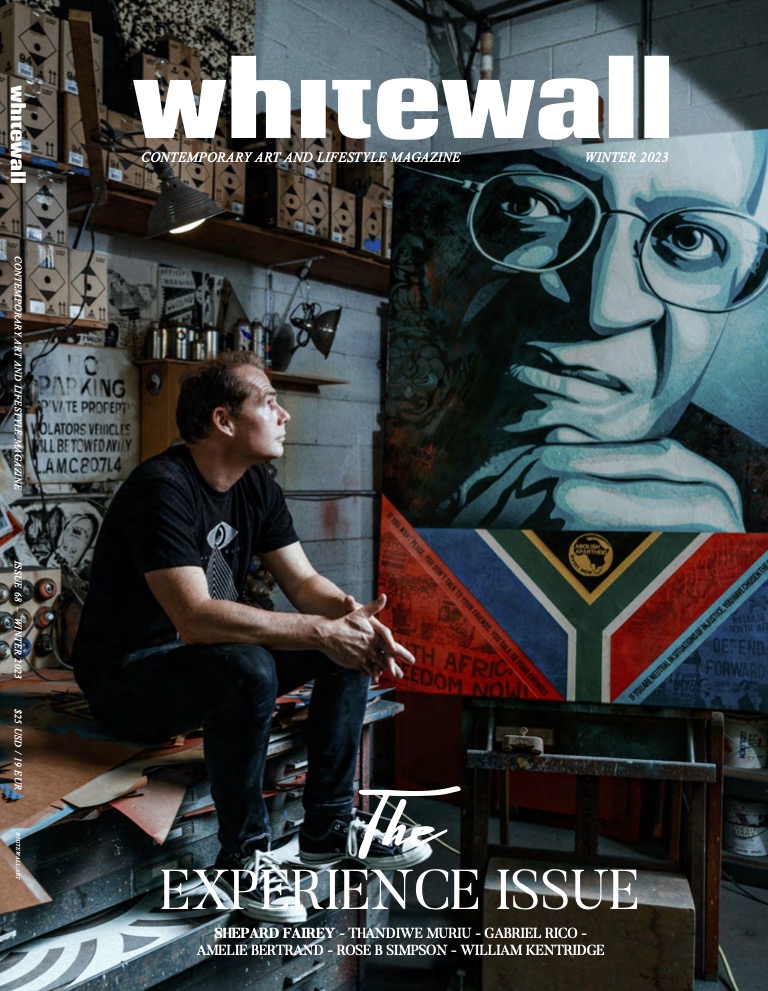 Photo of Shepard Fairey by Mike Allen.
Photo of Shepard Fairey by Mike Allen.
WW: You’ve been exploring power and structure for years. From where did your activist spirit stem?
SF: I grew up in Charleston, South Carolina, which was very preppy and traditional, and I felt frustrated with a lot of the social dynamics. Of course, I was aware of racism and that Charleston was racially divided black and white 50/50, with the white half being the top 50 percent economically and the black half being the bottom. I didn’t understand racism or hierarchies based on family history and wealth, but lots of things didn’t sit right with me as a teen.
When I discovered punk rock, like the Dead Kennedys and The Clash, and reggae like Bob Marley, I began to think about art and music as tools of activism. It took a long time for this to coalesce in my art practice, but I had great role models like Robbie Conal and Barbara Kruger along the way.
Over the years, I’ve become more socially and politically engaged and sophisticated, so I feel more confident expressing my point of view in my work. I think art is about problem-solving visually, but why not add the additional layer of problem-solving socially, if possible? I see this multifaceted approach as a way of using all of my skills to address everything I care about.
WW: Recently when posting an image of your work on Instagram, you said, “obedience is the most valuable currency.” How are you thinking about obedience in your work today?
SF: Up until the pandemic, and the rise of QAnon, I felt that questioning obedience and encouraging dissent was always the right way to go. However, I’ve realized that in a post-truth world, people are sometimes manipulated into disobeying things that actually benefit society. Vaccination and voting rights, in my opinion, are good for society, but many people have been misled to turn against them. That being said, the people benefitting from manipulation are ironically achieving obedience to their agenda through encouraging the disobedience of those who will listen to them. I know that might sound convoluted, but what I’m saying is questioning obedience is still very important to me, but what is being obeyed has gotten more complicated.
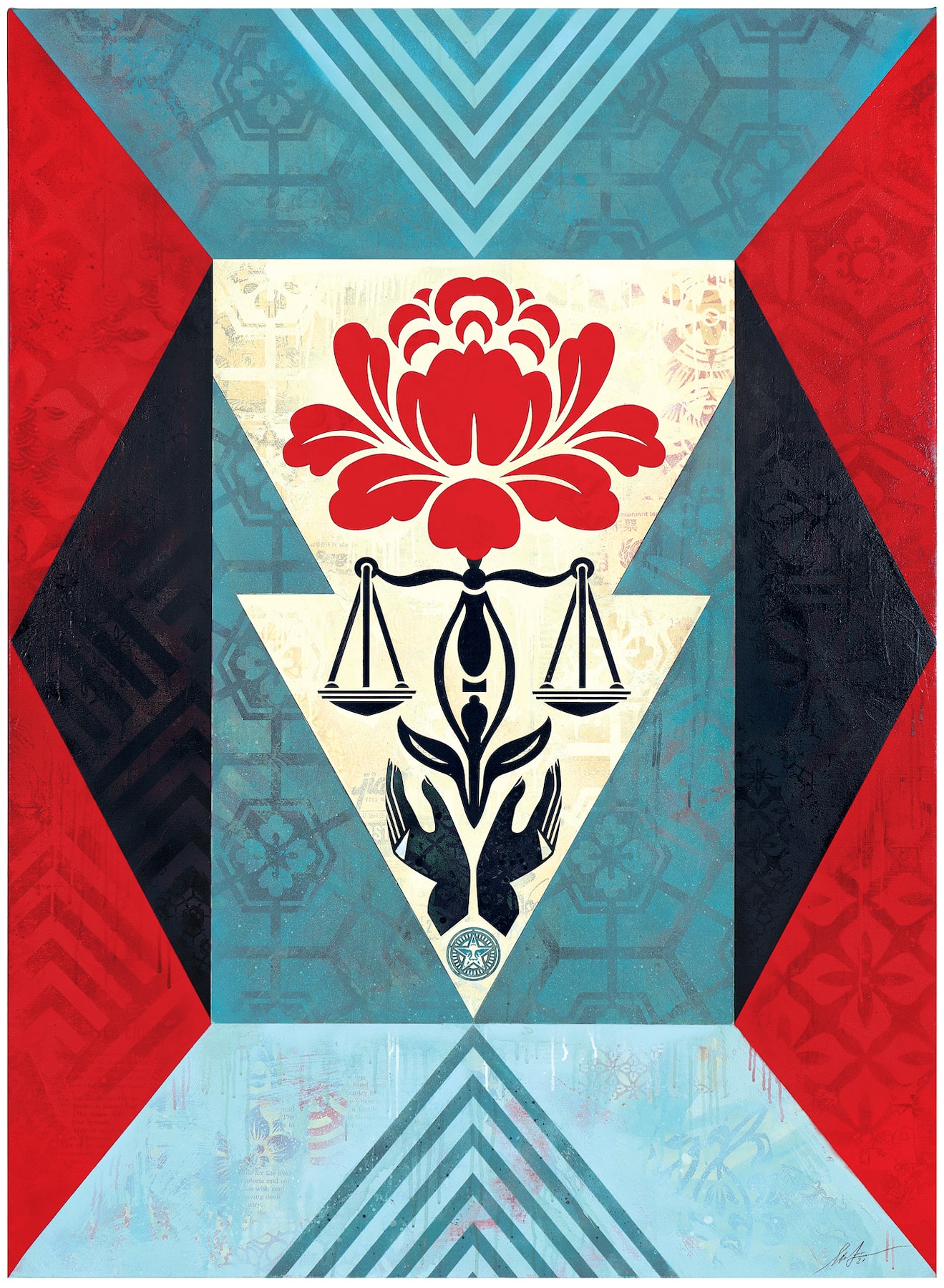 Shepard Fairey, “Cultivate Justice, Red,” 2021, courtesy of the artist.
Shepard Fairey, “Cultivate Justice, Red,” 2021, courtesy of the artist.
WW: Some of your recent works touch upon moving away from fossil fuel reliance to more sustainable energy resources, and you’re supportive of Greenpeace USA and a new Global Ocean Treaty. How does the natural world impact your work?
SF: I find a lot of beauty in the natural world, even though I’m basically a city person. I also understand that respecting the delicate balance of the natural world’s ecosystems is essential to avoid catastrophic changes that humans and other species will suffer from and have difficulty adapting to. Most people, even if they don’t consider themselves hippies, or outdoorsy, can appreciate the beauty of the ocean, flowers, clouds in the sky, and other elements of the environment that we often take for granted but enrich our lives. I use many of those elements in my work because I think they consciously and subconsciously register as sacred things that should not be destroyed.
WW: How do you want the art you create to change the way people think? Act?
SF: I think that we’re all overwhelmed by the amount of media we are confronted with or even choose to consume, which creates a selective focus to avoid being overwhelmed. I don’t mean this in a condescending way. I think that it’s easy to fall into a sort of junk food diet of the media we consume, so I hope to create work that can grab people’s attention outside of their usual patterns, and encourage them to think about things that impact them and the rest of society or the rest of the planet. If people aren’t stimulated to consider some of these issues, they will never be motivated to act. The first step is to lead someone into a conversation that might change their mind about all the topics I address in my work. Art has a different emotional impact than a newspaper editorial or a dry political podcast. Half the reason that I was excited to engage socially was that my heroes like Chuck D and Joe Strummer were cool people who made cool art. I’m hoping that at least some of my art has that same appeal.
WW: Last year, we spoke about your collaboration with Mike Dean on an NFT project. How has your work in the Web3 space evolved since then?
SF: The Web3 space is great for building community and empowering creatives. Despite the positive aspects of that world, I initially found it challenging to make purely digital work that I felt could bring value to my art practice and uphold my philosophies. When I discovered what was possible with generative NFT projects, I finally saw the potential to marry my love of making multiples at affordable prices with my belief in the importance of making art special and experimental. My generative project “DEGENERATE/REGENERATE” opened my eyes to unexpected cropping, colors, and juxtapositions of my imagery, which largely led to my “Modular Discourse” series of fine art. I’ve always worked back and forth between analog and digital, so I now see some of the aspects of Web3 and AI as potentially inspiring or enhancing my experimentation with what I do in my art studio.
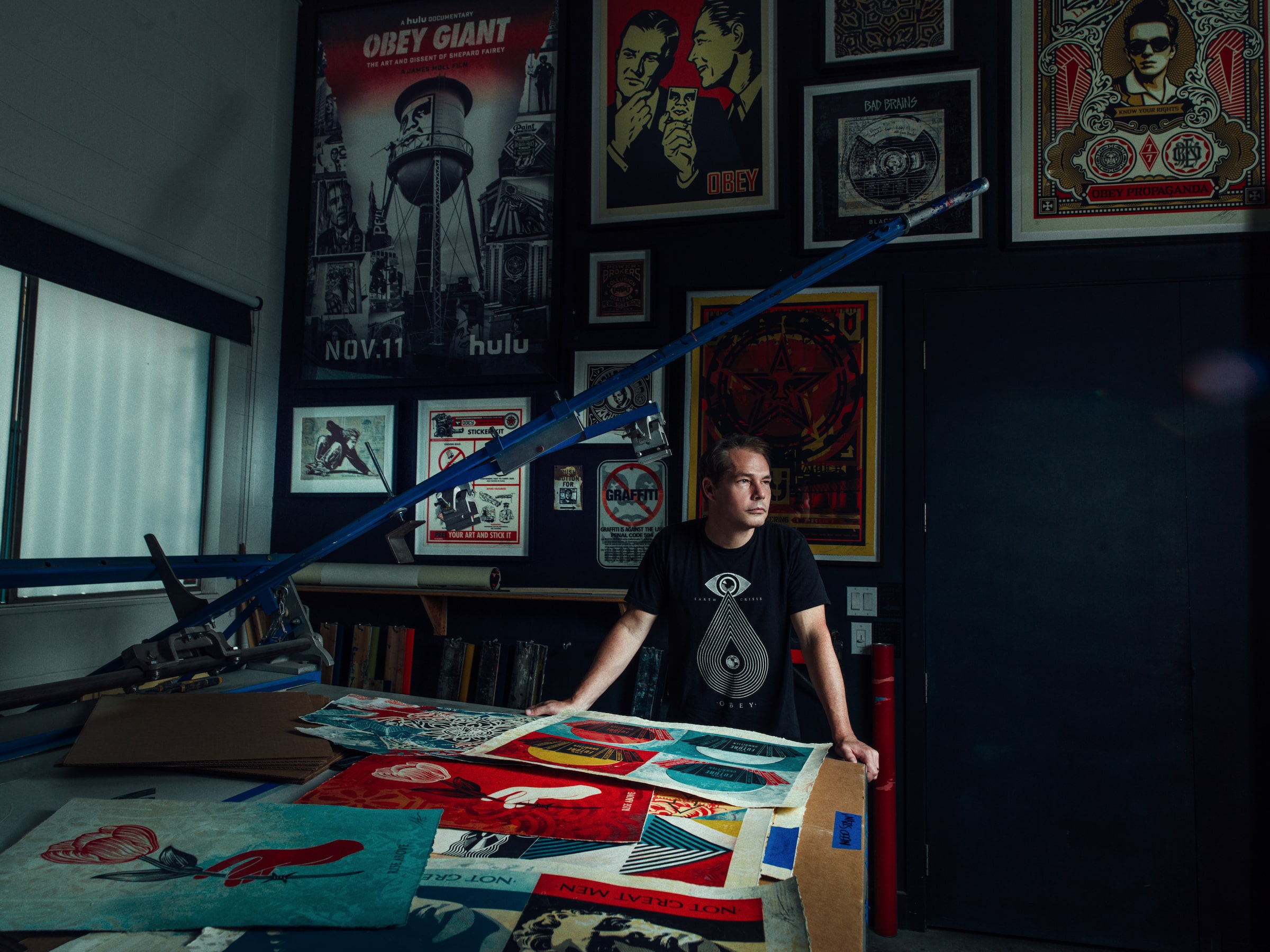 Photo of Shepard Fairey by Mike Allen.
Photo of Shepard Fairey by Mike Allen.
WW: We recently interviewed your friend Cleon Peterson, who shared how you helped him get back into society and the art world after bouts of addiction and incarceration. What role does friendship play in your practice?
SF: Despite a few misanthropic moments, I generally care about people. When I was younger and felt out of step with many of my peers, finding friends in skateboarding and punk rock who I related to was essential to not feeling completely isolated and depressed. It also gave me the courage to stand up for things I believed in when I knew I could find solidarity with even a small group of people. I also struggled for the first ten years of my art career, and supporting and having the support of my close friends kept me going when at times I thought I might be smarter to give up art.
Cleon Peterson is a phenomenal artist and person, who, in many ways, is one of a kind, but in other ways he is just one of many people who I think the world will benefit from having access to—not just their art but also their voice. We have a gallery where we show established and emerging artists, but the emphasis is on giving opportunities to people who might not find them elsewhere. Even the established artists mostly came from unorthodox places.
WW: Can you tell us a bit about your studio in L.A.?
SF: I know I’ve referenced punk rock a lot, but the way The Clash described themselves as a garage band, I was for many years a garage artist. My first studio in L.A. was a one-car garage, then I moved to a luxurious two-car garage, but in late 2008 I could finally afford a real studio. My studio is in an industrial area along the L.A. River called Frogtown. I first got a 4,500 square-foot space where I did all my screen-printing and fine art and stored art in a dusty loft and a cleaner, dust-free room. In 2017 I purchased the building behind Studio 2, also known as The Deuce, and now all of the screen-printing and art supplies are stored in that space. I’m fortunate to have an ideal setup with those adjacent studio spaces.
I have plenty of room to work largely on the floor and several stations and easels for my small crew of assistants and me. I also have a design studio and gallery about five minutes away in Echo Park. I spend my days between the two studios and spend more time at one or the other, depending on my focus that day. I always go into the art studio in the morning and work onpaintings and collages while giving my assistants directions. This is often my favorite part of the day because I love working hands-on with paint and other materials. I go into my design studio for the afternoon to work on illustration and graphic design while also overseeing the projects my design studio and design assistants are working on. I often have to sign screen prints or offset prints, which we ship out of the same building as the design studio and gallery.
I go home for dinner, and then I start working again at home at night, either on illustration or graphic design. I spend some time with my kids and frequently watch TV or documentaries at night while I work, but the amount of work I take on means that I have to work a two-shift day, even if my nights can include a little bit of escapist entertainment also.
WW: Does being a parent impact your artmaking?
SF: Yes, because I’m thinking about the world my kids are inheriting and the challenges they will face. It’s a cliché, but having kids forces you to think about more than just yourself. A lot of the aspects of my work that I would have considered too sappy or sincere before I had kids come naturally as a genuine emotional response to family connection and, by extension, connection to people in general.
WW: What are you working on in 2023?
SF: I have a show opening in November in Munich at AMUSEUM of Contemporary Art, and I will be doing the second leg of my collaborative show with D*Face and Kai & Sunny in Taipei at some point in 2023. I have a bunch of murals in the works as well. After two museum shows and two solo shows in 2022, I’m excited to have space to recharge and experiment without as much pressure.
WW: What do you feel is your responsibility as an artist?
SF: My responsibility is to create more than just precious, escapist, or decorative things. Those things are fine as ingredients, but for me, make a bland stew. I feel it’s important for me to have the courage to speak my mind and challenge people, especially when I know that silence only allows injustice to persist.
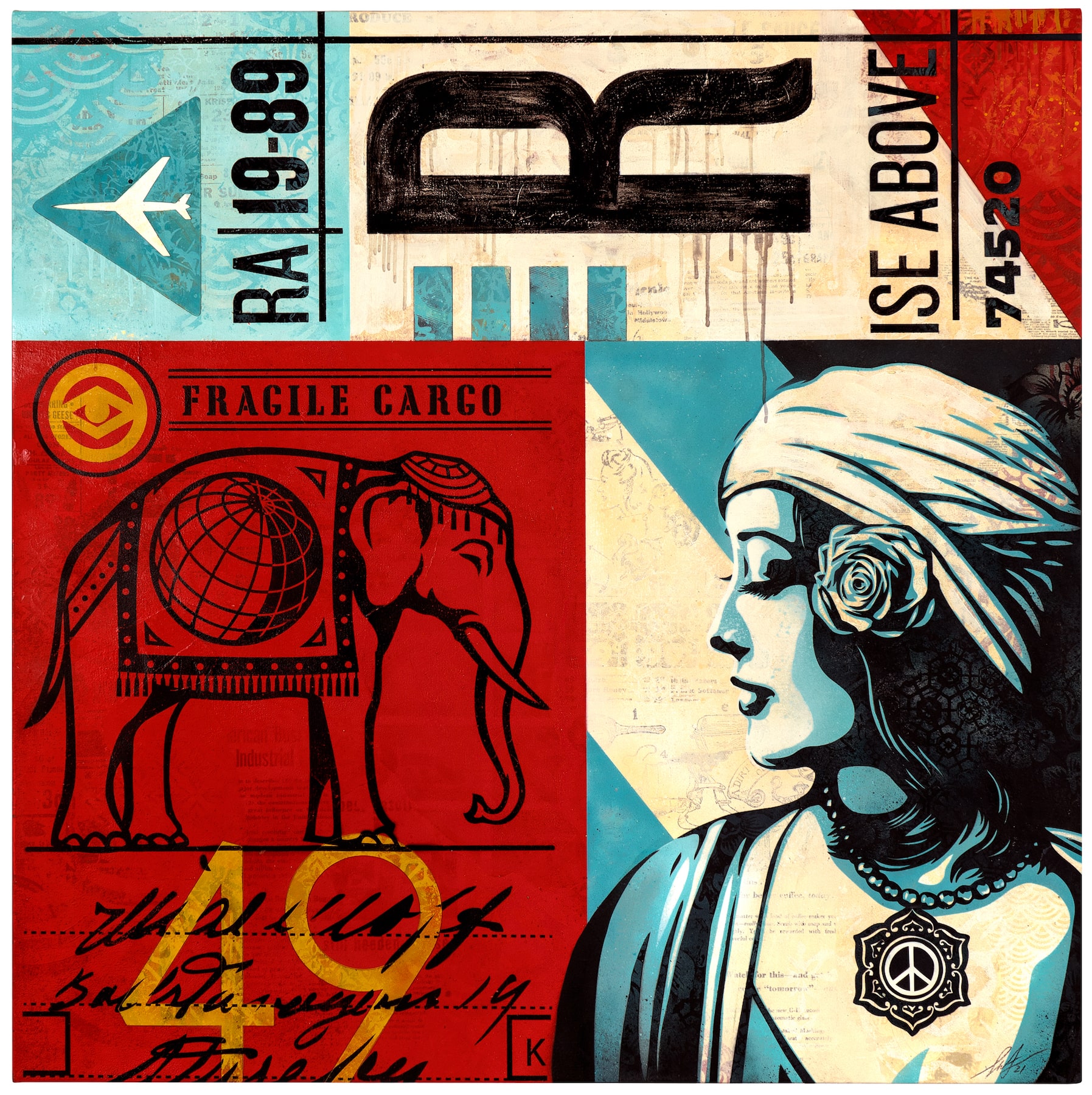 Shepard Fairey, “Fragile Cargo, Version 2,” 2021, courtesy of the artist.
Shepard Fairey, “Fragile Cargo, Version 2,” 2021, courtesy of the artist.
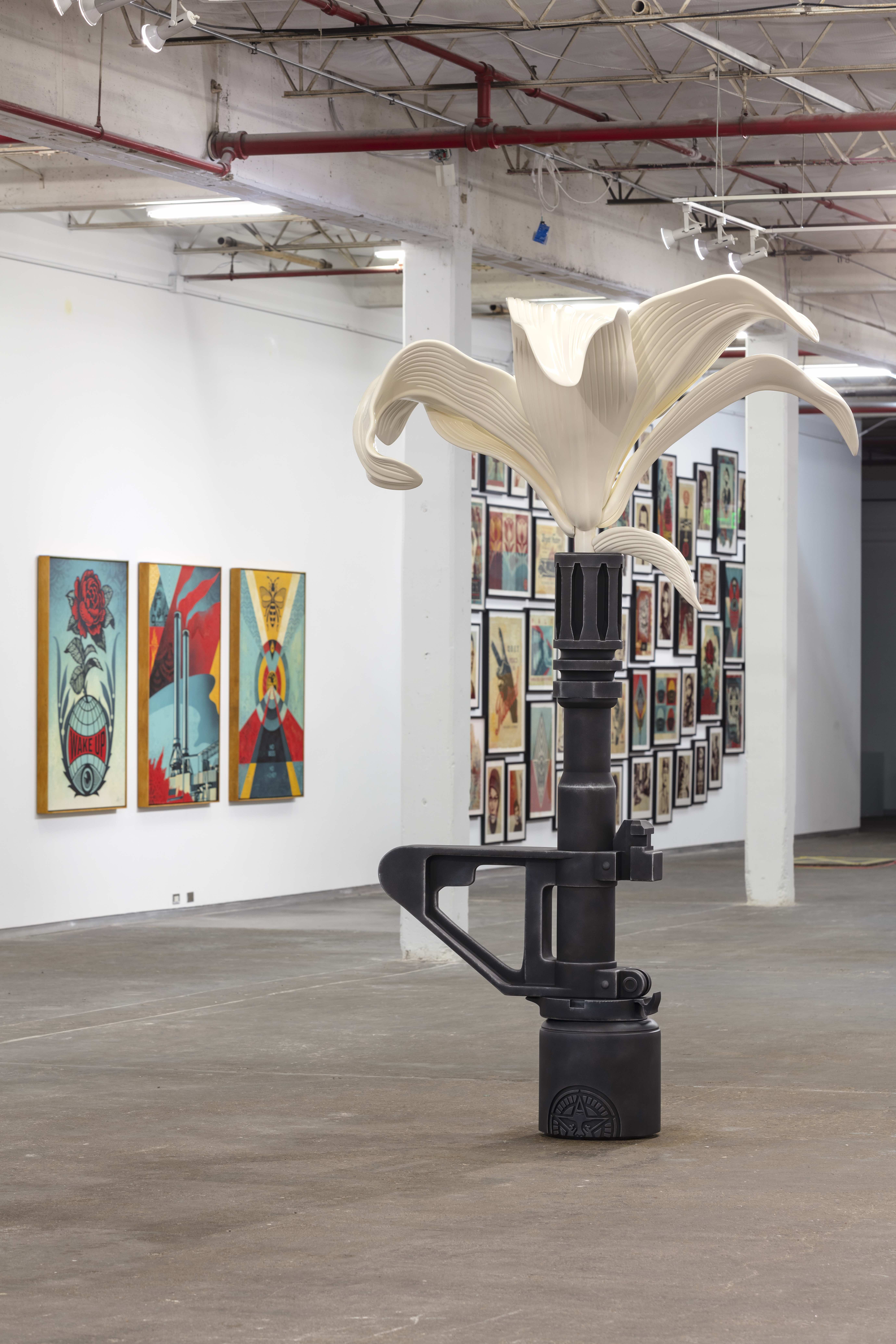 Shepard Fairey, installation view of “Backward Forward” at the Dallas Contemporary, photo by Kevin Todora, courtesy of the artist.
Shepard Fairey, installation view of “Backward Forward” at the Dallas Contemporary, photo by Kevin Todora, courtesy of the artist.






